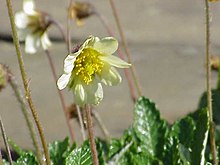| Dryadoideae | |
|---|---|

| |
| Dryas × suendermannii | |
| Scientific classification | |
| Kingdom: | Plantae |
| Clade: | Tracheophytes |
| Clade: | Angiosperms |
| Clade: | Eudicots |
| Clade: | Rosids |
| Order: | Rosales |
| Family: | Rosaceae |
| Subfamily: | Dryadoideae (Lam. & DC.) Sweet |
| Genera | |
| |
The subfamily Dryadoideae consists of four genera in the family Rosaceae,[1] all of which contain representative species with root nodules that host the nitrogen-fixing bacterium Frankia.[2] They are subshrubs, shrubs, or small trees with a base chromosome number of 9, whose fruits are either an achene or an aggregate of achenes.[1] It includes five genera (Dryas, Cercocarpus, Chamaebatia, Cowania, and Purshia), all of which except the first only occur in North America.
- ^ a b Potter D, Eriksson T, Evans RC, Oh S, Smedmark JEE, Morgan DR, Kerr M, Robertson KR, Arsenault M, Dickinson TA, Campbell CS (2007). "Phylogeny and classification of Rosaceae". Plant Systematics and Evolution. 266 (1–2): 5–43. doi:10.1007/s00606-007-0539-9..
- ^ Swensen SM, Mullin BC (1997). "The impact of molecular systematics on hypotheses for the evolution of root nodule symbioses and implications for expanding symbioses to new host plant genera". Plant and Soil. 194 (1/2): 185–192. doi:10.1023/A:1004240004063. JSTOR 42948119..